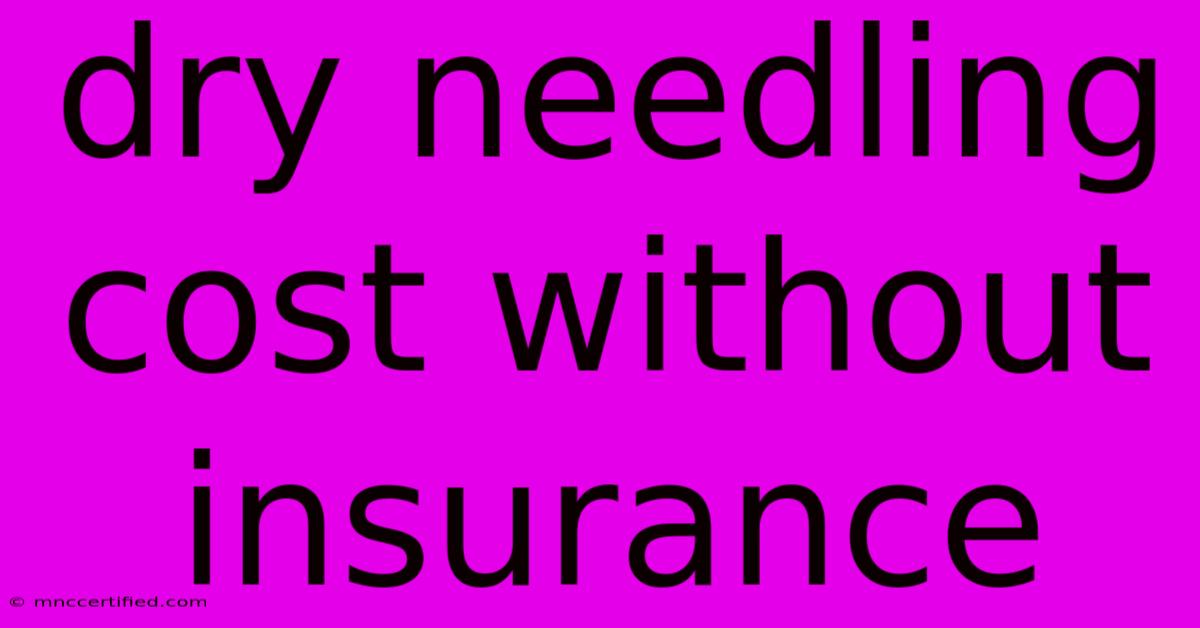Dry Needling Cost Without Insurance

Table of Contents
Dry Needling Cost Without Insurance: What to Expect
Dry needling is a popular treatment option for chronic pain, muscle tension, and other musculoskeletal issues. It involves inserting thin needles into specific trigger points in the muscles, which can help release tension and improve pain relief.
While dry needling can be an effective treatment, many people are surprised by the cost, especially without insurance. This article will break down the typical dry needling cost without insurance, factors influencing price, and tips to save money.
What is Dry Needling and How Does it Work?
Dry needling is a technique that uses thin, sterile needles to stimulate trigger points in muscles. These trigger points are areas of tight, contracted muscle fibers that can refer pain to other parts of the body. When the needle is inserted into the trigger point, it causes a localized twitch response that helps to release the tension and improve pain relief.
Dry Needling Cost Without Insurance: Breaking Down the Price
The cost of dry needling without insurance can vary widely depending on a few factors:
- Location: Dry needling costs tend to be higher in metropolitan areas compared to rural regions.
- Practitioner: The experience and expertise of the dry needling practitioner can also impact the price.
- Number of Treatment Sessions: The number of dry needling sessions needed to achieve desired results can significantly influence the overall cost.
- Length of Session: A longer treatment session will generally be more expensive.
- Additional Treatments: Some practitioners may offer other therapies alongside dry needling, which can increase the total cost.
On average, you can expect to pay between $50-$150 per dry needling session without insurance. However, it is essential to contact individual practitioners in your area for accurate pricing information.
Tips for Saving Money on Dry Needling Without Insurance
Here are some helpful tips to minimize the cost of dry needling without insurance:
- Shop Around: Contact multiple practitioners in your area to compare prices and find the best value.
- Ask About Packages: Some practitioners offer package deals for multiple sessions, which can save you money in the long run.
- Check for Discounts: Inquire about any discounts offered for new patients, referrals, or paying in cash.
- Consider Alternative Payment Options: Some practitioners may accept financing options or payment plans.
Is Dry Needling Worth the Cost?
Ultimately, the decision of whether or not dry needling is worth the cost is a personal one. However, if you are struggling with chronic pain, muscle tension, or other musculoskeletal issues, and have exhausted other treatment options, dry needling may be a worthwhile investment.
Other Options to Consider
If you are looking for alternative pain relief options, you might consider:
- Physical Therapy: Physical therapists can provide a range of treatments for musculoskeletal pain, including manual therapy, exercises, and modalities like heat and ice.
- Massage Therapy: Massage therapy can help to reduce muscle tension and improve circulation, which can be beneficial for pain relief.
- Acupuncture: Acupuncture is a traditional Chinese medicine practice that uses thin needles to stimulate specific points on the body. Like dry needling, acupuncture can be effective for pain relief.
Conclusion
The cost of dry needling without insurance can be a significant expense. By understanding the factors influencing price, utilizing cost-saving tips, and exploring alternative options, you can make an informed decision about whether dry needling is the right choice for you.

Thank you for visiting our website wich cover about Dry Needling Cost Without Insurance. We hope the information provided has been useful to you. Feel free to contact us if you have any questions or need further assistance. See you next time and dont miss to bookmark.
Featured Posts
-
Kristi Noem Trumps Pick For Homeland Security
Nov 13, 2024
-
Full Match Report Wanderers 2 1 Fleetwood Bsm Trophy
Nov 13, 2024
-
Best Boat Insurance For Older Boats
Nov 13, 2024
-
Black Parade Tour My Chemical Romance Live Again
Nov 13, 2024
-
Former Disney Star Skai Jackson Announces Pregnancy
Nov 13, 2024